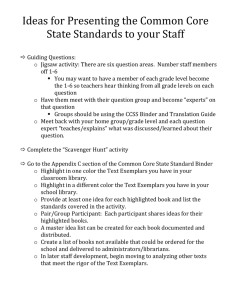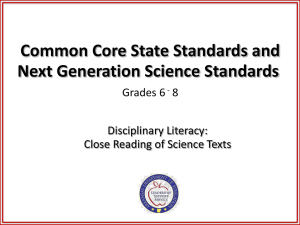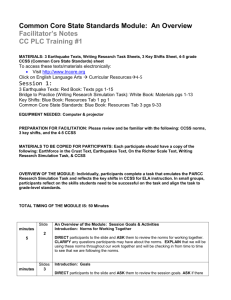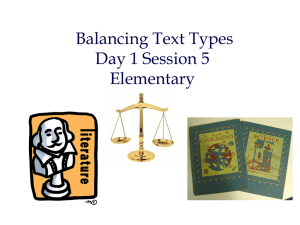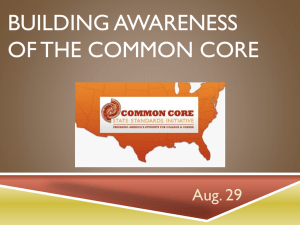Annotated Bib
advertisement
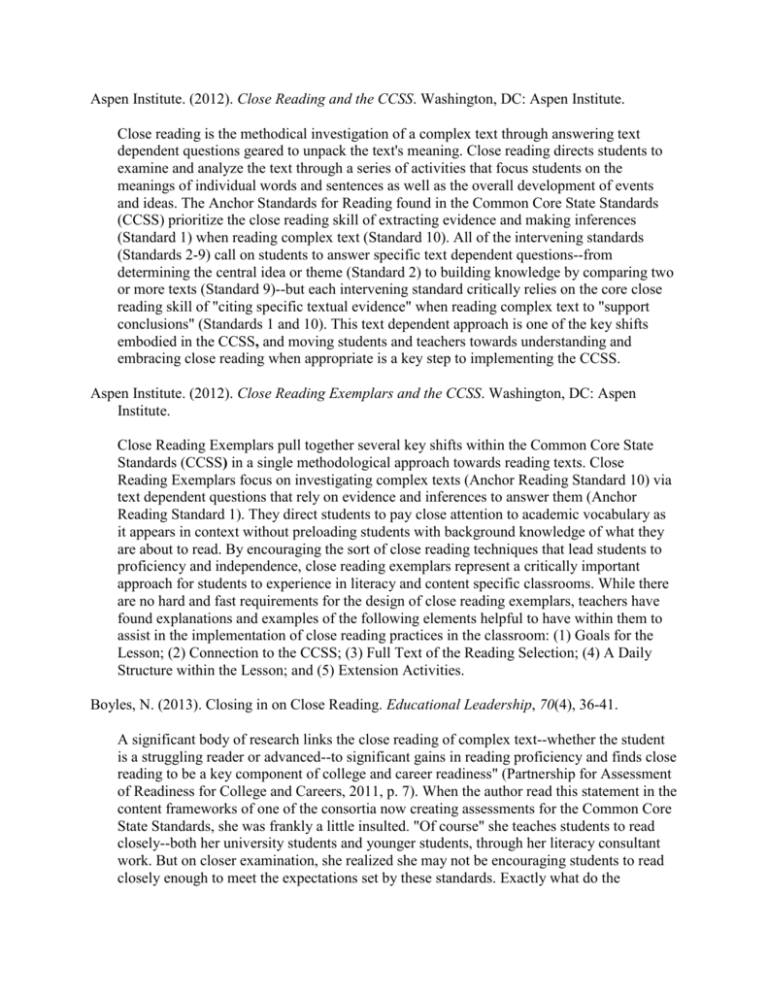
Aspen Institute. (2012). Close Reading and the CCSS. Washington, DC: Aspen Institute. Close reading is the methodical investigation of a complex text through answering text dependent questions geared to unpack the text's meaning. Close reading directs students to examine and analyze the text through a series of activities that focus students on the meanings of individual words and sentences as well as the overall development of events and ideas. The Anchor Standards for Reading found in the Common Core State Standards (CCSS) prioritize the close reading skill of extracting evidence and making inferences (Standard 1) when reading complex text (Standard 10). All of the intervening standards (Standards 2-9) call on students to answer specific text dependent questions--from determining the central idea or theme (Standard 2) to building knowledge by comparing two or more texts (Standard 9)--but each intervening standard critically relies on the core close reading skill of "citing specific textual evidence" when reading complex text to "support conclusions" (Standards 1 and 10). This text dependent approach is one of the key shifts embodied in the CCSS, and moving students and teachers towards understanding and embracing close reading when appropriate is a key step to implementing the CCSS. Aspen Institute. (2012). Close Reading Exemplars and the CCSS. Washington, DC: Aspen Institute. Close Reading Exemplars pull together several key shifts within the Common Core State Standards (CCSS) in a single methodological approach towards reading texts. Close Reading Exemplars focus on investigating complex texts (Anchor Reading Standard 10) via text dependent questions that rely on evidence and inferences to answer them (Anchor Reading Standard 1). They direct students to pay close attention to academic vocabulary as it appears in context without preloading students with background knowledge of what they are about to read. By encouraging the sort of close reading techniques that lead students to proficiency and independence, close reading exemplars represent a critically important approach for students to experience in literacy and content specific classrooms. While there are no hard and fast requirements for the design of close reading exemplars, teachers have found explanations and examples of the following elements helpful to have within them to assist in the implementation of close reading practices in the classroom: (1) Goals for the Lesson; (2) Connection to the CCSS; (3) Full Text of the Reading Selection; (4) A Daily Structure within the Lesson; and (5) Extension Activities. Boyles, N. (2013). Closing in on Close Reading. Educational Leadership, 70(4), 36-41. A significant body of research links the close reading of complex text--whether the student is a struggling reader or advanced--to significant gains in reading proficiency and finds close reading to be a key component of college and career readiness" (Partnership for Assessment of Readiness for College and Careers, 2011, p. 7). When the author read this statement in the content frameworks of one of the consortia now creating assessments for the Common Core State Standards, she was frankly a little insulted. "Of course" she teaches students to read closely--both her university students and younger students, through her literacy consultant work. But on closer examination, she realized she may not be encouraging students to read closely enough to meet the expectations set by these standards. Exactly what do the Common Core standards mean by close reading? And what principles and practices should guide educators as they implement close reading in the classroom--particularly in elementary classrooms? Much of the available information about close reading centers on secondary schools, where this skill seems to fit most comfortably. By the time students are in these later grades, they are more inclined to think abstractly. They read complicated texts by great authors that beg for careful analysis. But close reading can't wait until 7th grade or junior year in high school. It needs to find its niche in kindergarten and the years just beyond if educators mean to build the habits of mind that will lead all students to deep understanding of text. Brown, S., Kappes, L., & Aspen, I. (2012). Implementing the Common Core State Standards: A Primer on "Close Reading of Text". Washington, DC: Aspen Institute. The Common Core State Standards represent an ambitious effort to improve teaching and learning at an unprecedented scale. Adopted by 45 states and the District of Columbia, these standards are an attempt to dramatically change what students and teachers do in school, by redefining high-level, thought-provoking instruction as the norm for all students in all schools. Among the most significant of the shifts in English language arts is the expectation that all students will be able to read increasingly complex texts proficiently and independently. Educators need to harness the knowledge of research, the wisdom of experience, and the imperative for improvement to implement Close Reading effectively within the context of a comprehensive literacy framework. Teachers have to be innovative and creative, while connecting decisions about instructional practice to the research on reading development and the explicit demands of the Common Core. Hence the authors recommend that practitioners: (1) Are deliberate and intentional determining when, and for what instructional purposes, Close Reading is employed. The goal is to move students to read closely, independent of the teacher; and (2) Understand that while engaged in Close Reading lessons, students naturally use prior knowledge to deepen their comprehension of the text. Teachers should activate prior knowledge and build background knowledge when appropriate, while ensuring that students' examination of text is the central means of conveying information.
